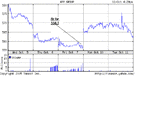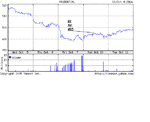fudgestain said:
This is simplistic and can misguide.
I don't need to use volume. Nevertheless I have said that volume can give a small clue if volume is the only thing or main thing a 'would be' trader uses.
I was a floor trader for a time and contrary to standard mythology selling moves the price upwards. When sellers retreat price moves up; when they take fright suddenly thats when price can shoot up. Vice versa for buying moving the price down.
As well you can have big volume going head to head without a big price move either way.
Happy detecting volume hunters.
🙂
When sellers retreat buyers have to step up to the plate or no transaction takes place. However, it could be said that buyers stepping up to the plate raises the price. The sellers retreating inniated it but the price only rose when buyers stepped up to the plate. They (buyers) could refuse to do so and the the sellers would have to then lower their offer to entice buyers. So, we could say ...what really moves the price up isn't because sellers retreat but because buyers are willing to raise their bid to meet the offer. However, I acknowledge the fact that if the sellers didn't retreat the buyers certainly wouldn't raise their bid. So we might say it takes both to raise prices. Sellers retreating and buyers raising their bid. But not always. If a big buyer comes in he could take everything offered (hit every offer) without a seller retreating. So, we are back to simple basics of demand and supply or better put PERCEIVED demand/supply or buying/selling pressures.
Most of the time concepts are better understood when explained in a simple form. The basic concept that I spoke of above I have see it happen many times ...maybe you don't???. I see it happen alot however, it is not be be taken as the ONLY thing to look at when trading. The size of the daily range. The open and the close. Support / Resistence levels, pivot points, the general trend and the previous few days context could all be considered ALONG with the volume to make a determination. I in no way meant to infer that all one had to do is to just correlate volume with the immediate price. I only explained it in simple terms to get the point across.
Maybe you don't need to use volume in your trading but I still maintain that tells an important story about "how" the immediate price was in fact made; thus giving one an indication of demand/supply or as some say buying/selling pressure. Alot of well known traders also see volume as important. Of course, in the end the only thing that matters is PRICE because we don't buy volume, however, volume can help one to see what the price will MOST likely do in the immediate future. A better to put it would be to say that volume can help to give a "clue" to buying selling pressures thus help to indicate areas of perceived demand/supply. If one can get a handle on the pressures then maybe this could be projected into the near future. Even though this thread isn't necesarily about level 2 ....as an example of volume ...one can watch a level 2 screen and see the transactions going across and could predict within minutes ..sometimes seconds of when price would rise to the next level of bid and ask. Nevertheless, even this isn't 100% because the MM's and the specialist play with the bid/ask size numbers neverthless, there are ways to tell when they are playing around with it. At any rate it usually is close enough to be able to make money.
In conclusion, IMO volume does have a story to tell about price. About buying/selling pressures. About support/resistance. About demand/supply. Whether or not one accepts the story or incorporates it into their trading..well.. that is up to each individual trader. Nevertheless, in the end PRICE is KING.
If one is an EOD trader volume can also be useful especially if one uses it in tape reading.


